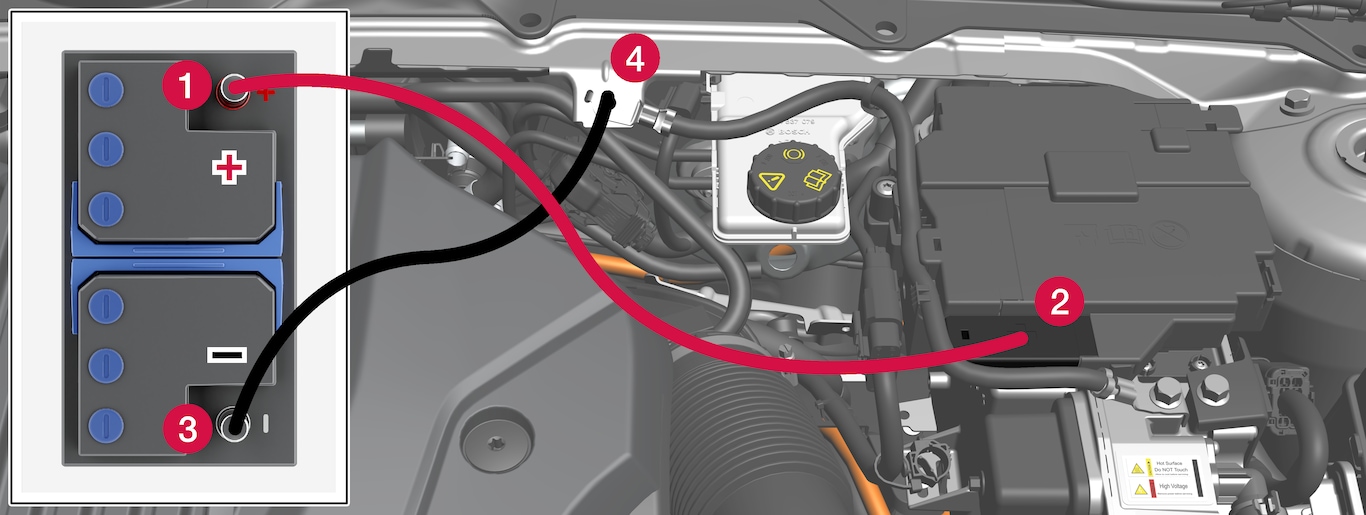
Important
The charging point of the vehicle is only intended for jump starting the vehicle in question. The charging point is not intended for jump-starting another vehicle. Using the charging point to start another vehicle could cause a fuse to blow, which would cause the charging point to stop working.
If a fuse has blown, 12 V Battery Fuse failure Service required will be displayed in the instrument panel. Volvo recommends contacting an authorized Volvo workshop.
To avoid short circuits or other damage, the following steps are recommended when jump starting the battery:
Put the ignition in mode 0.
Make sure the auxiliary battery (the battery used to jump start the discharged battery) has a voltage of 12 volts.
If the auxiliary battery is in another vehicle, turn off that vehicle's engine and make sure that the vehicles are not touching each other.
Clamp the red jumper cable onto the auxiliary battery's positive (+) terminal (1).
Important
Connect the jump cable carefully to prevent short circuits with other components in the engine compartment.
Fold back the cover over your vehicle's positive (+) jump start terminal (2).
Clamp the other end of the red jumper cable to your vehicle's positive (+) jump start terminal (2).
Clamp the black jumper cable onto the auxiliary battery's negative (-) terminal (3).
Clamp the other end of the black jumper cable to your vehicle's negative (-) ground point (4).
Make sure the jumper cables are securely attached to help prevent sparks while jump starting.
Start the engine of the assisting vehicle and let it run for a few minutes at a higher idling speed than normal, about 1500 rpm.
To activate the vehicle's electrical system, press and hold the start button for at least 5 seconds without pressing the brake.
Note
During normal start conditions, the vehicle's electric motor will be prioritized and the gasoline engine will remain off. This means that after the start button has been pushed in, the electric motor has "started" and the vehicle is ready to be driven. Start of the electric motor is indicated by the indicator lights on the instrument panel going out and its preselected theme illuminating.
Important
Do not touch the connections between the cable and the vehicle during the start attempt. Risk of sparking.
Wait at least two minutes to charge the start battery and then try to start the engine again.
If the engine still doesn't start, repeat steps 11 and 12.
Remove the jumper cables in the reverse order ‒ first the black cables and then the red cables.
Make sure that none of the clamps of the black jumper cables come into contact with either vehicle's positive (+) jump start terminals or either of the red jumper cable's connected clamps.
Warning
PROPOSITION 65 WARNING! Battery posts, terminals, and related accessories contain lead and lead compounds, chemicals known to the state of California to cause cancer and reproductive harm. Wash hands after handling.
Warning
- Batteries generate hydrogen gas, which is flammable and explosive.
- Do not connect the jumper cable to any part of the fuel system or to any moving parts. Avoid touching hot manifolds.
- Battery fluid contains sulfuric acid. Do not allow battery fluid to contact eyes, skin, fabrics or painted surfaces.
- If contact occurs, flush the affected area immediately with water. Obtain medical help immediately if eyes are affected.
- Never expose the battery to open flame or electric spark. Do not smoke near the battery. Failure to follow the instructions for jump starting can lead to injury.
Note
The vehicle cannot be started if the hybrid battery is discharged.